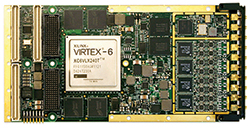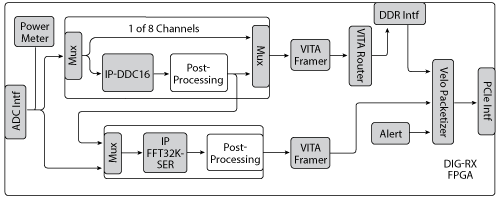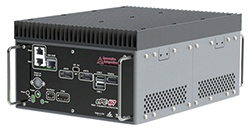This article provides an overview of the application trends and high level challenges of signal monitoring that system engineers are facing as well as a drill-down into the critical factors and trade-offs that need to be taken into consideration for successful deployment.
The challenges of designing signal monitoring and digital receiver applications are multiplying with escalating field deployment scenarios. System engineers are facing increasingly complex functionality and performance specifications for signal capture and analysis, while simultaneously coping with a variety of size, mobility, environmental, ruggedization, communications and software integration requirements. The high cost and inflexibility of conventional monolithic spectrum analyzers is too much for most of today’s field deployment scenarios (e.g., remote facilities monitoring, mobile spectrum analysis, software defined radio, surveillance, signals intelligence). On the other hand, trying to build the entire system from the chip-level up is impractical for most system integration projects, where the design engineers need to keep focused on the big picture objectives, with both schedule and budget also being critical factors. To meet the demands of today’s requirements while providing an adaptable basis for tomorrow, system engineers need access to a variety of digital receiver and signal processing building block choices, along with system integration options and standards-based modular software.
Escalating Application Demands
Across a widening range of industry segments and specialized applications, high-end digital receiver functions and signal analysis applications have migrated beyond traditional fixed location installations into more mobile “go anywhere” platforms that support a variety of field deployment activities. In both military and commercial applications, the need to put highly flexible signal monitoring systems out in the field has become critical for surveillance, software-defined radio (SDR), GSM front-end receivers, digital receiver/recorders, spectrum monitoring and regulatory enforcement activities. The various usage scenarios can include vehicle-based deployments, airborne, shipboard, cell tower, mobile transportable modular monitoring stations or fully ruggedized systems.
An increasingly important segment is within military and covert agencies to provide surveillance and signals analysis, such as capturing the RF signature for a particular environment and then monitoring in real-time for changes that may indicate attempted intrusions or security breaches. This can require a great degree of frequency-hopping flexibility and overall system adaptability. Depending on the scenario, covert signal analysis systems may require mobility and extended field deployment with the flexibility to track specific software-defined parameters that are unique to each situation. For example, a system might need to scan for signals at certain frequencies and then begin recording the streamed data only under those conditions. Some covert scenarios could even require the software to recognize specific patterns of associated frequencies, modulations and/or signals activity to trigger actions by the computing platform.
If real-time streaming and recording of RF data is a requirement, the system implications are significant, because the hardware must be capable of sustained conditioning and digitizing of I/Q data on-the-fly. Also, real-time recording will require significantly more local storage, such as large, fast solid-state drives (SSD). If streamed and recorded data needs to be quickly communicated from remote locations, the networking structures and communications bandwidth also become critical.

Figure 1 XMC FPGA-based digital receiver.
System Architecture & Digital Receiver Optimization
In general, most of the above applications consist of two key functions: the digital receiver and the digital processor. The digital receiver is responsible for digitizing, tuning, down-converting and filtering the desired signal. The digital processor is responsible for manipulating the baseband data to extract the desired information, such as demodulation, and managing the actions to achieve the overall application objectives. The key to successful system design is breaking up the various system elements into the optimal building blocks for meeting the application performance specifications while also achieving size, weight, power and cost objectives.
One important element that can often be segmented and optimized is digital receiver functionality. Since this function is relatively the same for any signal monitoring, SDR or spectrum analysis application, it can be effectively handled by a turnkey digital receiver approach – as long as the receiver meets the performance specifications for the primary application and integrates seamlessly within the overall system architecture. Using a turnkey digital receiver approach also has the advantage of enabling systems engineers to keep focused on the big picture design objectives and not worry about reinventing digital receiver functionality from the ground up. The digital receiver thus provides the heart of the signal monitoring process flow, allowing engineers to focus on building the rest of the applications functionality around it.
To provide maximum flexibility for configuring a variety of different systems for various deployment scenarios, it is advantageous to implement the digital receiver subsystem on a standards based format at the lowest possible building block level. For example, a solid foundation for effectively integrating digital receiver functionality into virtually any higher level system design can be achieved by implementing a field-programmable gate array (FPGA) based digitizer module with multiple digital down-converter (DDC) channels and integrated fast Fourier transform (FFT) functionality in a single block that can be installed on a standard XMC-PCIe mezzanine board. The key is providing sufficient performance and flexibility within the basic module level to meet the application’s frequency range, sampling rates, bandwidth, signal-to-noise ratio (SNR) and streaming transfer rate requirements.

Figure 2 Digital receiver block diagram.
Figure 1 shows such an XMC-based digital receiver module built around a Xilinx Vertex-6 FPGA with 128 DDC channels integrated with eight, 14-bit 250 MHz analog-to-digital converters (ADC). Each DDC has its own programmable tuner, lowpass filtering and programmable decimation rate, thereby supporting 128 independent output bandwidths up to 800 kHz. This gives system engineers a variety of options to record data directly from the ADCs or to down-convert the modulated analog RF channels to the target IF band. Figure 2 illustrates the process flow through the digital receiver module. The data is packetized in standard VITA 49 format by the framer, with accurate timestamps and synchronization to the external pulse-per-second (PPS) signal. An embedded power meter monitors power levels at the ADC inputs in order to give designers the option to incorporate analog gain control in the external front-end device.
By interfacing the XMC-based module with an appropriate external front-end RF-to-IF analog-capture device and a standard PC system via the PCIe interface, engineers can quickly create a full signal monitoring or spectrum analysis system. In addition, the ability of the VITA router to interface directly with a digital data recorder (DDR), serving as virtual first in first out (FIFO) for data buffering, allows for easy configuration of high speed sustained streaming to the recorder. The ability to embed custom firmware in the IP cores also allows the same module-level digital receiver hardware to be adapted for specialized functions if required.

Figure 3 Building blocks for a signal monitoring platform can be integrated into a rack-mountable or stand-alone box.
System-Level Integration
Of course, the basic system described above needs to be adapted to the specific requirements of each application scenario. Using a commercial off-the-shelf (COTS) approach, many application requirements can be addressed by integrating all of the other elements within a rack-mountable or stand-alone PCIe-based enclosure (see Figure 3). This allows system engineers to take a true building-block approach to put together all of the hardware components and focus primarily on the application software. However, in some instances it may be necessary to further reduce size, weight and power or to simplify deployment and field service by creating small, fully self-contained systems. In these instances, the same core FPGA-based digital receiver module functionality can be easily embedded with the associated processor and other elements within a “brick” module. This can be especially useful for many military or covert surveillance applications that require either a high degree of portability or installation in confined spaces, for airborne or vehicle deployments.
If digital recording of the data is a requirement, then the system design needs to take into account the size, location and interfacing of the appropriate recorder and storage functions. Key considerations include off-loading the main processor and keeping it from being a bottleneck in the data flow. The ability to interface the FPGA-based digital receiver module directly to a recorder helps to overcome both of these issues. Depending on the amount of recorded data that has to be stored locally, the appropriate amount of SSD storage can be interfaced to the recorder and accessed by the main processor. To maximize performance, it may be necessary to dedicate specific SSDs to the recorder, rather than using them as shared system resources.
Other issues that come into play with system design include environmental factors, which may call for ruggedization, shock mounting and/or conformal coating. Depending on the nature of the specific application, these requirements may be addressed at the module, system level or both. Here again, the modular nature of the turnkey FPGA-based approach offers flexibility for easily adapting the digital receiver functionality within the overall environmental system strategy.
Conclusion
System flexibility is a critical factor for implementing today’s signal monitoring and spectrum analysis functions, especially for military, covert and security applications. The ability to leverage powerful modular building blocks along with industry standards and software interoperability can often be the key to timely development and successful systems design.
System designers generally don’t have the time, skill-set or resources to build every basic function, such as digital receivers, from the ground up. They also don’t have the luxury to compromise on system performance or to hassle with the inability to customize functions for their particular application requirements. Instead, they need to leverage adaptable building block solutions that are optimized for performance, functionality and integration flexibility. This approach enables designers to optimize hardware integration by minimizing space, power and complexity while maximizing system differentiation through firmware and systems-level software customization for specialized features.
